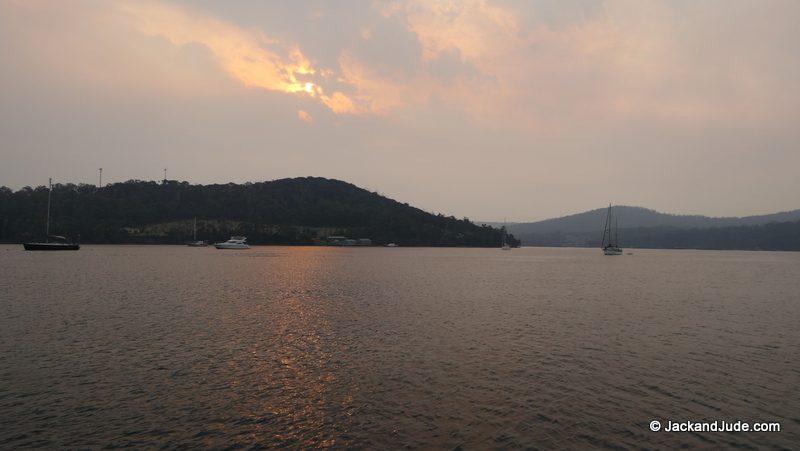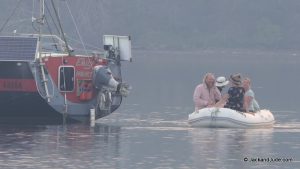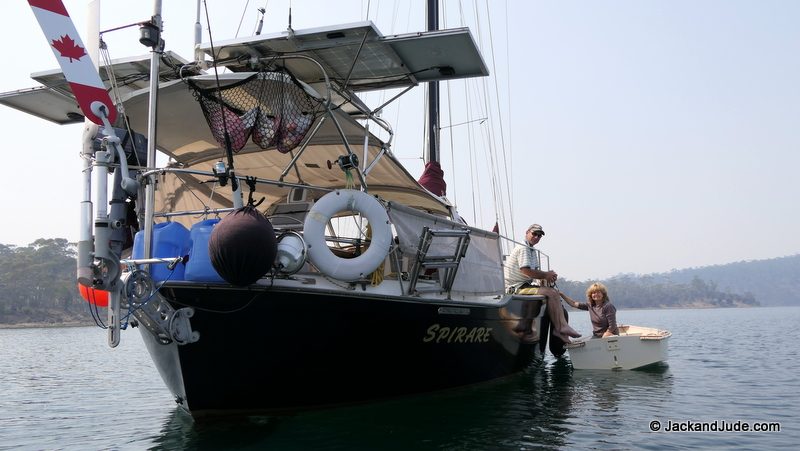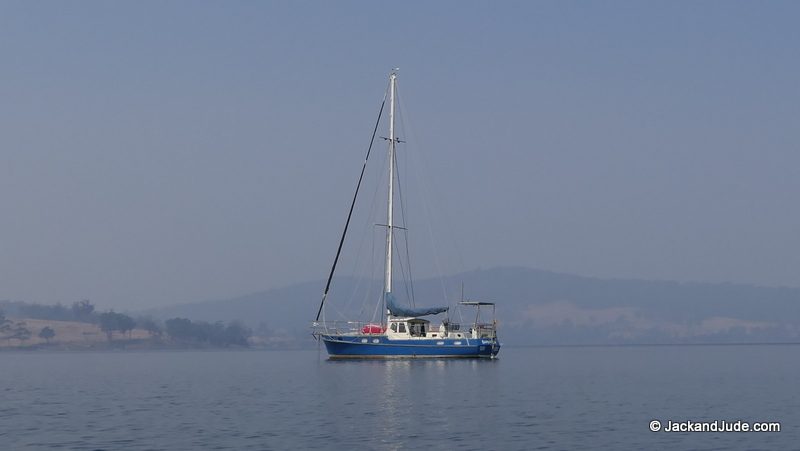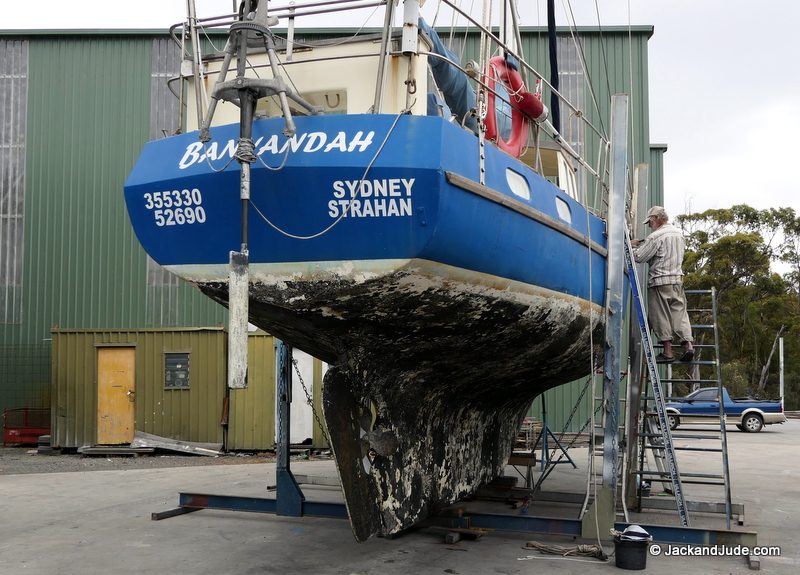February 2019 January 2019 >>
Blog of Jack and Jude
explorers, authors, photographers & videographers
Halcyon Days Obscured
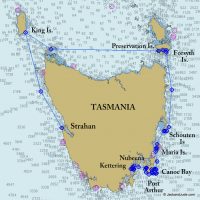 Once safely inside the Nubeena anchorage at Parsons Bay, Banyandah settled into a calm state of nirvana that hit maximum bliss over the Australia Day long weekend. Before those three glorious festival days, we re-victualed our sorry larder with fresh goodies from the handy IGA that lay a mere hop, skip, and paddle from our floating home. The only hitch being timing our crossing of the hugely wide, drying sand flats that took a bit of strategic planning, but once mustered, we knew precisely when to brave the rigours awaiting us ashore, where it was hot and often irritatingly smoky.
Once safely inside the Nubeena anchorage at Parsons Bay, Banyandah settled into a calm state of nirvana that hit maximum bliss over the Australia Day long weekend. Before those three glorious festival days, we re-victualed our sorry larder with fresh goodies from the handy IGA that lay a mere hop, skip, and paddle from our floating home. The only hitch being timing our crossing of the hugely wide, drying sand flats that took a bit of strategic planning, but once mustered, we knew precisely when to brave the rigours awaiting us ashore, where it was hot and often irritatingly smoky.
Just when we were getting the hang of things, a bolt out the blue from our past showed up. Yonks ago when sailing round the world was something everyone hankered to do, there were several floating families hove together up the Klang River in Malaysia. With us was Brian, who had recently lost his wife in strange circumstances, converting his yacht for a special delivery to an unnamed country. And another was this likable lad with rusty coloured hair with his wife and child, doing any odd job that had anything to do boats.
Reminiscing
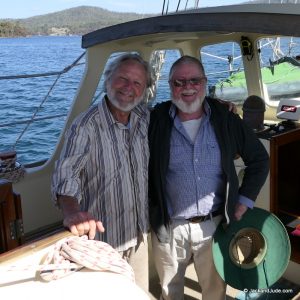 Forty years down the track, this rusty haired lad now living in Tasmania contacts us. Brief messages between us revealed that he had pursued a maritime career, and we suggested he drive down to meet us. Uh-oh, his hair is no longer rusty coloured. In fact, all three of us are fifty shades of grey, but all of us can still sail a boat – just about anywhere.
Forty years down the track, this rusty haired lad now living in Tasmania contacts us. Brief messages between us revealed that he had pursued a maritime career, and we suggested he drive down to meet us. Uh-oh, his hair is no longer rusty coloured. In fact, all three of us are fifty shades of grey, but all of us can still sail a boat – just about anywhere.
Reminiscing is such good fun when you have something in your lives worth recalling, so between the three of us we talked up a storm from moment one, for pretty near the next thirty-six hours. And it was so much fun that we have something on the boil for later down the log.
Australia Day was very special. Jack and Jude joined the local scene right from the get-go and participated in the local Peninsula Aquatic Club Renegade Regatta. Well, sort of. We were visiting cheerleaders and storytellers, and we had a lot of fun chatting with the local sailors. Then we moseyed over to the local craft fair, where we were amazed by the quality of talent. Even more impressive were the stories we heard from the artists. It’s a great way to learn local history first hand and get a good grip on what makes a place special. So we went home hoarse from non-stop talking to the local folk.
Tasmania on Fire
Although almost everything was glorious, the one hang-up was the smoke haze and acrid smell that drifted in and out on the changeable breeze. At its worst, we couldn’t see 500 metres! And it caused such great worry for us deeply regretting the loss of wildlife and forests, while worrying about how the fallout would affect our painting Banyandah. Seemed the whole state was engulfed in fire, a tragedy effecting all Taswegians.
Isn’t it well past time that we humans recognize the impact our massive population is having on this lovely bit of magic we call Earth. How ridiculous to think we, meaning the billions of humans, running cars, flying in aircraft, burning fossil fuels for heat and energy, can go on doing so without changing the dynamics of the planet. Hey, we live on a ball floating in space and there ain’t no Plan B. Imagine for a moment the creator of all this is testing us. Remember, we are unique, with such great powers.
Final Romp to Slipway
Okay, back to life on the briny: We needed to get to our lady to her appointed moment to be hauled out the water so we tracked the weather as furiously as kids texting each other. It’s just so handy to watch the weather systems unfold and be able to predict nearly exactly the moment to lift the anchor for a perfect sail. We had seen our moment coming, and had planned our whole happenings around departing at 12 noon the following Saturday. Nope, no overtime applied, real sailors sail on good wind whenever it arrives. And so when the first skerrick of northerly breeze touched our cheeks we sailed.
By the time we’d cleared the fish farms, yes, Nubeena has them as well, a lovely 12 knot breeze filled our sails, and as predicted it got stronger every minute that afternoon till we were romping along propelled by twenty knots and looking for quieter water. That arrived perfectly at Dennes Point when we gybed all sail to broad reach at near max speed down “The Channel.” That’s what the locals call the D’Entrecasteaux Channel, a narrow waterway protected on each side by Bruny Island and Tasmania. The channel is the most popular boating area in all of Tasmania, with literally hundreds of anchorages in bays and inlets. Our destination, The Oyster Cove Marina, located at Kettering, lay just a few miles from the top end. We sped down channel till opposite our haul-out point then zipped into the complex of many bays opposite it to get ready for our big day two days hence.
While having a paddle around the next morning we met Serge and Joanne, French Canadian’s on a steel yacht called Spirare, which in Latin means breeze, or breathe like in respire. Serge told us many other words from this Latin root that we’re not able to recall at just this moment because our head is filled with their sorry tale of visiting Australia. Their love of Australia is their problem. It seems Australia only allows visitors a maximum stay of two years, and then they must go. Now Segre and Joanne are not young and therefore cannot apply for residency. But it’s not that they want. All they want is to stay longer. They spend near twenty thousand dollars a year in the local economy while living in their own floating home, so they are paying their way and are no burden on the community. Once they paid quite a hefty full price for some needed medical attention. So, in fact they are never a burden and actually support our economy. But the rules say, two years only, and then you must go. So, listening to their tale of woe we wondered why? Now they’re preparing their vessel for a sail back to New Zealand, a country they told us will gladly take many like them. You make up your own minds on that one.
Hard Yakka
Okay, moving onto the trials of our older bodies revitalising our vintage craft knowing that we’ll write a full report on the facilities here at the Oyster Cove Marina once we’ve completed the full tour. But for now, we’re up to our eyeballs in Hard Yakka. For those of you who do not own a vessel or those able to hire labour to do this tiring work, we’ll explain. Imagine something as big as a forty-foot container but has no flat sides nor is close to the ground. Instead it stands over head-height on a narrow comb with all the real work way up above mere mortals. Making things much tougher, it lives in a marine environment requiring very special coatings and then even before applying those touchy chemicals, the marine growth has to be removed and the surface prepared, which on our veteran lady is a bit pock-marked like a demented witch that has had a hard life. Scrape, scrape, sand, sand: Ouch! Our shoulders are hurting, and all the time we’re climbing up and down two stories while, most importantly, all the time carefully watching our every footing. And there’s more: Always outside, exposed to the sun and wind, and rain.
Of course there’s a financial cost. Haul-out costs we’ll report later when we’re back in the water, but the paint, anodes, brushes, rollers, thinners, masking tape, and sanding gear, etc, etc, so far runs to a thousand dollars. No charge for our labour! So, any of you contemplating owning a boat, rub away those rose coloured images of basking beside a white sandy beach with a tall glass of bubbly, and get real. This is serious work.
We’re not whinging. We’ve done this before, and will gladly do it again, well, maybe not gladly, but there are positives. A ship looks after a person’s well-being. She provides a home and is the magic carpet to extraordinary places not reachable by any other form of transport. And she gives a quality of life that is truly memorable. Now, when all is said and done, if we are fortunate enough in coming years, we’ll be able to spin some yarns that will lighten up our eyes, not just with pride in what we achieved; but with an inner glow remembering the wonderful places we’ve experienced and the magical wildlife we’ve witnessed. For all that, the price starts with Hard Yakka.
Wooden Boat Festival
We took a day off from our Hard Yakka when good friends loaned us their second car to drive up to Hobart on a rainy Saturday to see what all the fuss was about with thousands vying for a look at timber vessels of all shapes and sizes. What we really wanted to see was an outcast from the others. A metal vessel we’d grown up hearing of her restoration and here was our chance to actually go on board the James Craig.
Plummeting insect numbers ‘threaten collapse of nature’
Biodiversity of insects is threatened worldwide. Here is a comprehensive review of 73 historical reports of insect declines from across the globe, and systematically assess the underlying drivers which reveals dramatic rates of decline that may lead to the extinction of 40% of the world’s insect species over the next few decades. More in Save Earth Now.
“Jude’s Fright” – Uncharted Rocks Update
Concise reply:
“Overall, I would very much like to thank you for bringing this to our attention in such a well documented way via a Hydrographic Note. Based upon your advice, we have already updated the official electronic and paper nautical charts, though it could be two years before those changes are reflected in the unofficial recreational charts – another challenge we are attempting to address. If you note (or recall) any other areas where the charts don’t reflect real-world features, we’d most appreciate hearing from you again.”
We wrote back and suggested that if they chose to name those rocks that they call them “Jude’s Fright.”
Full Reply from Hydrographic Office
A valuable read to better understand accuracy of both paper and electronic charts
The Australian Hydrographic Office responds…
By Mike Prince
Director, National Charting Program
Australian Hydrographic Office
Firstly, I’d very much like to thank Jack and Jude of the SY Banyandah. They took the time to submit a very comprehensive Hydrographic Note to the AHO that has already resulted in changes to both the official electronic and paper nautical charts. The only thing I can’t confirm is how long the changes will take to appear in the private ‘chart plotter’ style charts.
Secondly, they very rightly posed the question “Why aren’t they on today’s charts?” The answer is simple – because the extensive rock formation couldn’t be seen on the later survey that replaced Matthew Flinders’ efforts. (of 1798)
Preservation Island was later ‘fully’ surveyed by Commander HJ Stanley of the Royal Navy in the period 1874 to 1877.
The rock shelf was drawn much smaller than in Flinders’ earlier version and was subsequently then partially covered by a depth value when incorporated in the British Admiralty chart of the era. It then remained that way for over 90 years, including within the last Admiralty chart, created in 1968. Although subsequently replaced by an Australian chart, even as late as 2002 when the latest full new edition was published the largest scale topographic maps didn’t show the rock shelf either, while use of satellite imagery was in its infancy at the time.
All this goes to show that, despite best efforts, the quality of a chart is dependent upon the quality and clarity of source information, and the efforts of our predecessors, both here and on the other side of the world. They’re very careful, but not infallible.
To address this, the AHO, along with many other nations, categorise the reliability of every large and medium scale chart. The system is known as Zones Of Confidence (ZOC), and there may be several different zones on every chart. In this case, the area was categorised as ZOC C, meaning that positions could be out by 500 metres, and that there could be numerous undetected features rising from the charted seabed. While official charts all show the different areas of confidence, this information isn’t included in the private ‘chart plotter’ style charts (user beware), and is the down-side of the convenience they offer. Information about the accuracy of electronic and paper charts is available on the AHO website at www.hydro.gov.au.
So what happened after Jack and Jude notified us? The Electronic Navigation Chart was updated immediately, and was available for download three weeks after being notified. The paper charts followed about two weeks later – all as a result of observant sailors caring about the safety of those who may follow in their wake. To them I say, thank you.
 |
 |
| Australian ENC AU441148 | Aus 798 and 800 |
Till next time, safe anchorages and fair winds.

